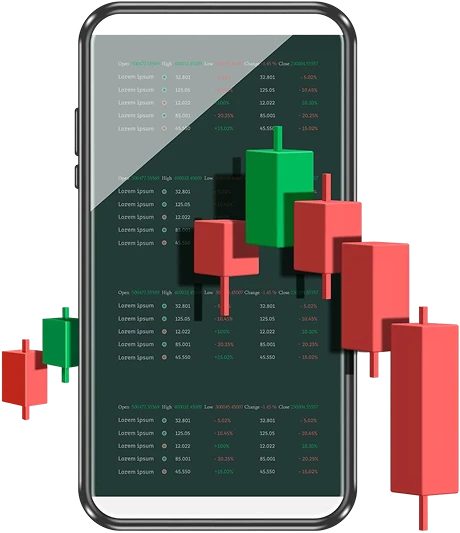Opulatrix
Opulatrix: AI Market Perspective Refined Daily


Through adaptive machine learning, Opulatrix observes subtle rhythm shifts, forecasting potential transitions amid volatility. This analytical alignment promotes steady reasoning, enabling disciplined observation and balanced execution timing as sessions evolve across different cycles.
For both experienced users and emerging participants, Opulatrix translates variable behavior into organised pathways using AI calibrated mapping. Each adjustment integrates stability with speed, delivering structured awareness without trade execution. Opulatrix provides intelligent analysis, layered monitoring, secure data management, and advanced adaptive frameworks.



Opulatrix employs adaptive sequencing to interpret swift transitions and stabilise directional focus. Every motion is assessed through comparative rhythm, identifying the earliest traces of deviation. Signals remain structured, guiding proportional responses that preserve consistency and adaptability during unpredictable intervals.
Within Opulatrix, analytical modules enable replication of pre tested strategies refined by professional systems. Each participant retains full autonomy, selecting approaches suited to personal analysis. Integrated AI layers generate calibrated prompts, ensuring each replicated motion follows disciplined reasoning. The system remains entirely separate from trading environments and performs no executions. Continuous alignment preserves analytical precision, supporting structured evaluation and maintaining clarity across variable conditions for consistent interpretive performance.

Security remains a central foundation of Opulatrix. Without executing trades or connecting to exchanges, it maintains encryption layers, rule based verification, and independent system reviews. Information is processed through secure channels where reliability, confidentiality, and analytical precision form the structural base. Continuous monitoring reinforces protection, ensuring that every analytical function operates with stability, transparency, and unwavering integrity across all operational layers.
Opulatrix functions as an analytical environment designed to support strategic reasoning rather than control it. Each participant operates within an adaptive space that enhances individual interpretation. Signals are reviewed, validated, and contextualised with accuracy while remaining detached from direct trading functions. Cryptocurrency markets are volatile, and losses may occur. Its structured independence ensures clarity, balance, and disciplined observation throughout changing analytical conditions.
Through constant surveillance, Opulatrix identifies emerging movements as they begin, not after they conclude. Contextual data is synchronised with current readings to ensure updates match live developments. During volatile phases, refined alerts help preserve orientation, guiding attention through changing activity across major market venues. Continuous calibration within the system strengthens responsiveness, maintaining analytical accuracy and composure through evolving market fluctuations.
Opulatrix integrates layered intelligence to stabilise erratic movements and sustain strategic reasoning. Instead of reacting to volatility, it channels data through refined evaluation, eliminating distortions and preserving interpretive order. Every recalibrated stream supports steady observation, ensuring proportion and discipline across rapid sequences. Through constant computation, Opulatrix transforms scattered updates into deliberate patterns that reinforce structured decision flow. Each adaptive filter removes excess fluctuation, maintaining reliable clarity and dependable rhythm throughout shifting market phases.
Built with responsive architecture, Opulatrix adjusts seamlessly to evolving market tempo. Its analytical design merges continuous signals into coherent perspective, converting high frequency variance into sustainable form. During unstable periods, calibrated insight stabilises interpretation and preserves proportional awareness. Consistent refinement within the framework reinforces structured balance, ensuring dependable clarity through fluctuating analytical conditions.
By combining historical benchmarks with real time calibration, Opulatrix recognises recurring formations within fast changing environments. Observed fluctuations are traced back to long term behaviour, identifying momentum shifts that connect immediate reaction with contextual depth across global activity cycles. Through consistent verification, it maintains interpretive continuity, ensuring analytical precision and balanced observation amid evolving market dynamics.
Continuously active, Opulatrix monitors live sequences to identify emerging adjustments with precision. Through layered AI processing, incoming data is filtered, refined, and aligned across multiple timeframes. Each signal undergoes structured verification, revealing sentiment variations and activity surges across global sectors. Consistent observation sustains interpretive flow through fluctuating liquidity, shifting phases, and evolving rotations. This perpetual calibration within the framework maintains analytical harmony, ensuring balance and accuracy throughout variable market conditions.
Opulatrix ensures smooth analytical continuity by transforming complex challenges into clear, manageable guidance. Its responsive structure assists users at every level, combining adaptive orientation with dependable system balance. Operating completely independent of exchanges, it performs no trade executions and retains rigorous security oversight, maintaining transparency and analytical focus in all conditions. Continuous refinement within the framework preserves structural integrity, reinforcing consistent performance and balanced interpretation across dynamic analytical environments.
Opulatrix functions without executing trades, ensuring complete analytical autonomy. Users retain control while the system detects tactical openings, alerting to potential pivots and structured ranges. Responsive design maintains balance between reaction and restraint, turning complex motion into measured direction founded on verified information.
Every signal within Opulatrix is protected by encryption and verified authentication. Its streamlined workspace supports quick comprehension, fast navigation, and organised sequencing for both emerging and advanced participants. Secure pathways and adaptive modules uphold analytical discipline, ensuring order and composure through fluctuating conditions. Consistent calibration within Opulatrix sustains clarity, reinforcing stable observation across all analytical environments.

AI assisted filters detect early transitions inside Opulatrix, identifying directional changes and recalibrating focus before acceleration occurs. Rapid comparisons outline balanced routes, helping users align near term decisions with longer objectives while maintaining consistency through variable conditions.

Opulatrix accommodates both agile adjustments and sustained observation. Compact intervals refine short term response, while extended cycles track structural shifts across broader trends. Each framework aligns timing, rhythm, and proportional movement to ensure every strategy remains coherent within evolving dynamics.
By correlating leadership transitions, advancing indicators, and sector based behaviour, Opulatrix maps pressure zones where market momentum converges. This analytical breadth helps detect potential reversals, define directional strength, and sustain clarity when structural balance rotates across varying time horizons.
Through layered evaluation and defined markers, Opulatrix refines planning by connecting position sizing, milestone tracking, and controlled exits into measurable structure. Each mapped stage aligns execution with practical context, transforming broad projections into disciplined action. Procedures replace impulse as targets convert into verifiable checkpoints that maintain focus during compression or volatility.
By integrating regime mapping and sectoral grouping, Opulatrix identifies stability within shifting motion. Its algorithm separates consistent rhythm from background turbulence, interpreting shifts in sentiment, liquidity, and engagement before broader reaction emerges. Each adaptive cycle recalibrates thresholds, adjusts reference points, and maintains alignment with prevailing flow, supporting balanced progression and contextual accuracy through evolving rotations.
Refinement models separate genuine structure from transient distortion. Automated algorithms filter excess data, isolating relevant formations that maintain directional integrity. Through this adaptive framework, it reinforces clarity, helping analysts align movement with consistent progression instead of irregular fluctuation.
By prioritising verified structure, Opulatrix delivers standardised signals that encourage methodical evaluation. Layered studies highlight confirmation points, refine timing, and establish disciplined entry sequences. The result is a framework of proportional rhythm and dependable mapping that sustains precision under pressure.

Using broad data sweeps, the system identifies early shifts in sentiment intensity across markets, tracing progression through liquidity patterns and session rhythm. These calibrated readings complement quantitative metrics, bringing balance between human tone and analytical evidence.
Aligned with verified observation, Opulatrix merges narrative behaviour with structural form. It tracks emotional acceleration and deceleration across assets, producing grounded interpretation that maintains focus, consistency, and analytical neutrality through uncertain intervals.

Policy adaptation holds weight. Within Opulatrix, structured modelling aligns short term fluctuations with broader strategic context, ensuring composure through reversals, volatile bursts, and extended compression. Every layer preserves focus, converting reactive noise into measured progression under varied macro environments.
By condensing dense updates into defined patterns, Opulatrix strengthens analysis precision. Data streams are restructured into clear sequences that sustain balance under pressure, giving participants a dependable system for disciplined evaluation and calculated execution.

By continuously mapping recurrence patterns, break levels, and rotational flows, Opulatrix establishes context before abrupt market transitions emerge. The system distinguishes stable rhythm from short lived impulses, guiding interpretation toward reliable proportion, continuity, and strategic readiness.

Instead of relying on chance, Opulatrix distributes exposure through structured diversification. Using AI assisted analysis of historical data, it studies correlations under market stress to reveal how individual components react together or diverge when volatility increases. Each scenario test refines durability, helping portfolios sustain proportion even through disruptive cycles.
By filtering data distortions, Opulatrix identifies directional shifts as they begin. Rapid fluctuations, compressed ranges, and micro trend inflections are flagged early, giving analysts time to adjust positioning with precision. This calibrated awareness transforms reaction into preparation, turning scattered motion into measured tactical alignment.
Momentum often accumulates before visibility emerges. Opulatrix captures these quiet build ups beneath surface volatility, tracing where energy condenses before wider moves unfold. Through layered analysis, genuine momentum is separated from background noise, maintaining clarity when short term turbulence conceals underlying strength.
AI based evaluation within Opulatrix translates erratic movement into structured signals. Each irregular surge or sudden correction is reorganised into recognisable rhythm, exposing hidden drivers shaping the broader flow. By decoding this volatility, Opulatrix creates readable patterns that guide strategic awareness before visible change materialises.
Because its models adapt in real time, Opulatrix stays aligned with evolving dynamics. Each recalibration reflects active motion, preserving contextual depth and analytical discipline. Users maintain steadiness amid market turbulence, guided by dependable frameworks that translate rapid changes into structured awareness.

Through machine learning, Opulatrix transforms vast data complexity into accessible, structured intelligence. Subtle variations once buried in dense datasets are extracted and reorganised into defined clarity, presenting a coherent overview that reveals actionable signals hidden beneath informational noise.
Whether exploring foundational learning or refining advanced research, participants gain from Opulatrix’s ordered environment. It simplifies dense analytical processes, harmonising layers of data into a unified format where each stage builds upon the last, fostering understanding without distortion or excess.
Opulatrix operates as an entirely independent analytical framework, separate from any exchange or transactional activity. Its structure focuses solely on observation and interpretation, ensuring no overlap between study and execution. Each analytical tier functions transparently, designed to illuminate evolving context rather than impose conclusive outcomes.
| 🤖 Entry Fee | No entrance fee |
| 💰 Incurred Costs | Free of any charges |
| 📋 Process of Joining | Registration is streamlined and fast |
| 📊 Subjects Covered | Education on Crypto assets, Forex markets, and Investment strategies |
| 🌎 Eligible Countries | Almost all countries are supported except the US |